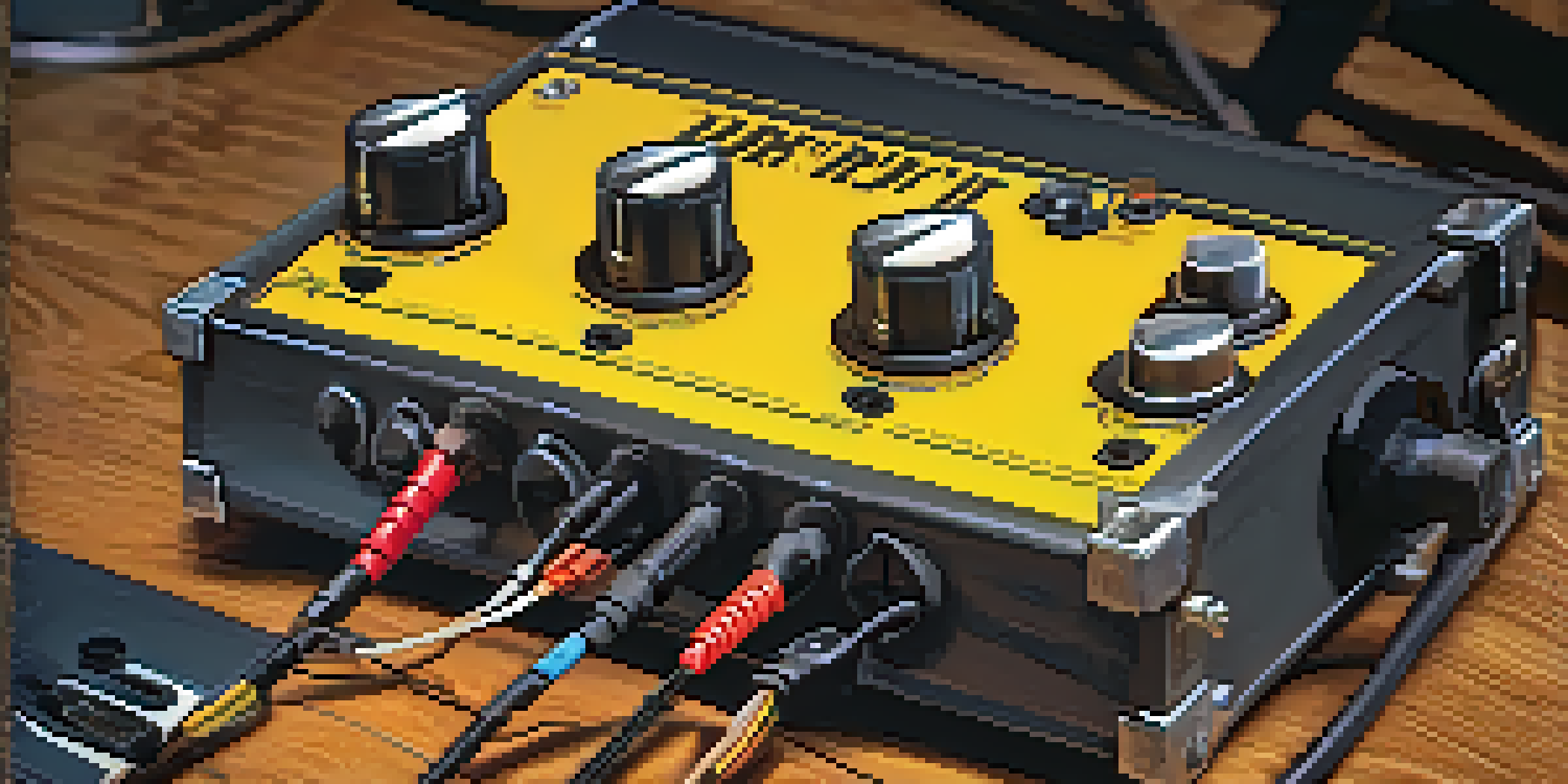DI Boxes: Essential Tools for Guitarists in Live Sound

What is a DI Box and Why Do Guitarists Need It?
A DI box, or Direct Injection box, is a crucial tool for guitarists, especially in live sound situations. It converts high-impedance, unbalanced signals from instruments into low-impedance, balanced signals that are ideal for mixing consoles. This transformation helps preserve sound quality and minimizes noise during transmission.
Good sound is half the battle in a live performance.
Imagine trying to send a message across a noisy room. If you’re talking loudly, your words might get distorted. Similarly, a DI box ensures that your guitar's signal remains clear and strong, even over long distances. Without it, you risk losing the nuances of your sound.
In essence, a DI box acts like a translator for your guitar, helping it communicate effectively with the sound system. This is especially important in large venues, where clear sound is key to engaging the audience.
Types of DI Boxes: Choosing the Right One for You
DI boxes come in two main types: active and passive. Active DI boxes require a power source, often providing better sound quality and handling stronger signals. They’re particularly useful for instruments with weak outputs, like passive pickups.

On the other hand, passive DI boxes don’t need external power and are typically more rugged and durable. They’re fantastic for high-output instruments, such as electric guitars. Choosing between the two depends on your specific needs and the type of gear you’re using.
DI Boxes Enhance Sound Quality
A DI box converts unbalanced signals from guitars into balanced signals, preserving sound quality and reducing noise in live settings.
Ultimately, understanding the differences can help you select the right DI box for your setup. Whether you opt for an active or passive model, each serves the purpose of ensuring your sound reaches the audience in the best possible quality.
The Benefits of Using a DI Box on Stage
Using a DI box on stage offers numerous advantages that can enhance your performance. One of the primary benefits is the reduction of interference and noise, which is essential for maintaining a pristine sound in live settings. This clarity helps your guitar tone shine through the mix.
The best way to predict the future is to create it.
Additionally, a DI box allows you to connect directly to the mixing board, bypassing the need for microphones. This not only simplifies your setup but also eliminates the risk of mic placement issues that can muddy the sound. It's like having a direct line to the sound engineer.
Moreover, DI boxes can help protect your gear. They often include built-in ground lift switches, which can eliminate hum and buzzing caused by ground loops. This means you can focus on your performance without worrying about unwanted distractions.
Setting Up Your DI Box: A Step-by-Step Guide
Setting up a DI box is straightforward, but doing it correctly can make a significant difference in your sound. Start by connecting your guitar to the input of the DI box using a standard 1/4-inch cable. This is your first step in ensuring a clean signal.
Next, connect the DI box's output to the mixing console using a balanced XLR cable. This connection helps maintain the integrity of the signal as it travels to the soundboard. Think of it as laying a strong foundation for a building; a solid base leads to a sturdy structure.
Choosing Between Active and Passive
Understanding the difference between active and passive DI boxes helps guitarists select the right option for their equipment and performance needs.
Finally, if your DI box has a ground lift switch, be sure to test it. This feature can help eliminate any unwanted hum. Once everything is connected, check your levels and adjust your sound settings, and you’ll be ready to rock!
Common Mistakes When Using a DI Box
Even experienced guitarists can make mistakes when using a DI box that can affect their sound. One common error is neglecting to use the ground lift switch, which can lead to frustrating hum and noise issues. Always remember to test this feature to ensure the best sound quality.
Another mistake is using the wrong type of cable. Connecting a high-impedance output to a low-impedance input without a DI box can lead to a weak and distorted signal. It’s crucial to use the right cables to maintain the integrity of your sound.
Lastly, many guitarists forget to check their levels after connecting to the mixing console. This oversight can result in either clipping or a weak signal. Always monitor your sound to ensure you’re delivering the best performance possible.
How to Maintain Your DI Box for Longevity
Maintaining your DI box is essential for ensuring it performs well over time. Start by storing it in a protective case when not in use to prevent damage from physical impacts. This simple step can prolong the life of your equipment significantly.
Additionally, regularly check all cables and connections for wear and tear. Frayed cables can lead to signal loss or unwanted noise, so addressing any issues promptly is key. Think of it like maintaining a car; regular checks can prevent major breakdowns later.
Proper Setup and Maintenance Tips
Correctly setting up and maintaining your DI box is crucial for ensuring optimal performance and longevity during live shows.
Finally, keep your DI box clean and free from dust. A quick wipe down with a microfiber cloth can keep it looking new and functioning well. By taking these small steps, you’ll ensure your DI box remains a reliable companion for all your performances.
The Future of DI Technology in Live Sound
As technology continues to evolve, so does the design and functionality of DI boxes. Newer models are incorporating features like digital connectivity and built-in effects, offering guitarists even more versatility on stage. This evolution is exciting, as it opens up new possibilities for sound manipulation.
Additionally, advancements in wireless technology might lead to the development of wireless DI solutions, allowing for even greater freedom of movement during performances. Imagine being able to roam the stage without worrying about cable tangles or signal loss – that’s a game-changer for live shows.

Ultimately, the future of DI technology looks bright, promising enhanced sound quality and more options for musicians. As a guitarist, staying updated on these developments can help you make informed choices about your gear and performance setup.